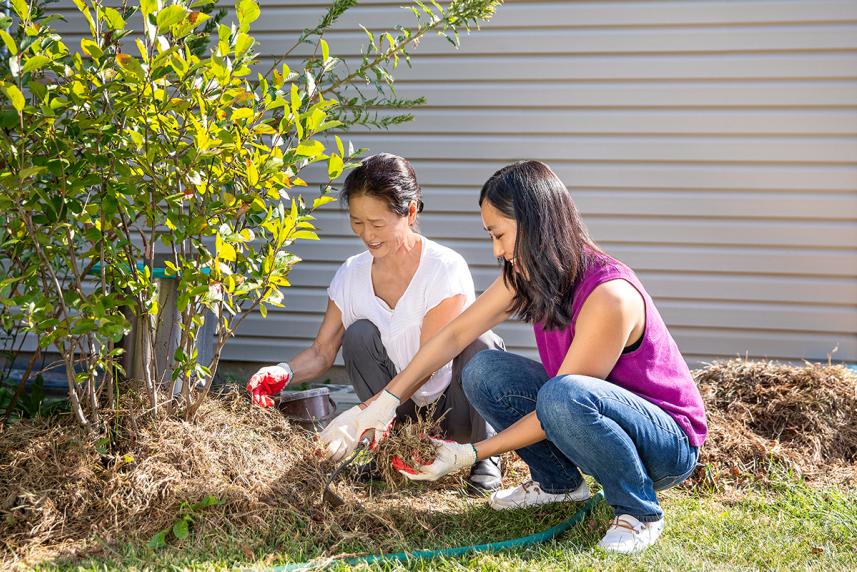
We have more than 90,000 doctors at over 2,000 locations. Our team will help you get the care you need, when and where you need it.

Making better lifestyle choices is key to staying well over the long run. Take charge of your health by following these simple steps.
What makes you feel like you’re on top of your life? A little extra money in your pocket? Crossing off all your to-dos? All good, for sure. Even better: Knowing that you’re doing everything you can to stay healthy for years to come.
It’s easy to let it go, though. Some people might even feel like their health is out of their control anyway. If you’ve got family members with a long-term (chronic) illness, you might just blame your DNA and forget about it.
Not so fast. Your good habits are super important for staying healthy, says Bethany Gray, DO. She’s a family medicine doctor and the medical director at Optum Orange County, California.
“We don’t have control over our genes and our family history. But we do have control over our lifestyle choices.” It’s never too late (and it’s always a good idea) to focus on your health.
You’ve got the power to get healthier, happier and stronger. Get started by adopting these smart habits today.

We have more than 90,000 doctors at over 2,000 locations. Our team will help you get the care you need, when and where you need it.
Getting regular exercise is one of the best things anyone can do for their health. Aim for at least 150 minutes of moderate physical activity per week.1 That’s about 30 minutes, five days a week.
Moderate activity means you raise your heart rate and break a sweat. Some examples of moderate activity:
If you prefer vigorous exercise, aim for at least 75 minutes a week. Vigorous activity means you are breathing hard and fast. Some examples include:
Also add muscle-strengthening exercises twice a week, too. That can include lifting weights, using resistance bands or doing moves that use your own body weight (such as push-ups, planks and squats).2 They can help protect your bones and help you maintain a healthy weight.3
Even two or more hours of activity a week can make a big difference, says Dr. Gray. “With that amount of activity, the American Cancer Society says you can reduce your risk of colorectal, breast and endometrial cancer.”4 (Endometrial cancer affects the lining of your uterus.) Those three kinds of cancer are big concerns for women.
But the benefits go way beyond cutting your cancer risk. Physical activity helps prevent other health problems too. It can cut the risk of diabetes, stroke, heart disease and more.3 That’s important, because heart disease is the leading cause of death for women in the United States. It causes about 1 in 5 female deaths.5
A nutritious diet can lower your chance of getting sick. That means adding more fruits, vegetables, whole grains, dairy and protein to your diet. It may also help prevent diabetes and heart disease. But it can be tough to make a lot of changes at once. Instead, try to make one small change a week to your diet. Here are some simple ways to get started:
Aim for less meat. You need protein, of course. But you can get it from plants, such as beans or lentils. (The average American eats about 20 ounces a day of meat. That’s much more than the five and a half to seven ounces per day recommended by the U.S. Department of Agriculture.6)
Watch your iron intake. Your blood needs iron to carry oxygen throughout your body. Women are more likely than men to be short on this important mineral. That’s because they lose blood during their periods. And pregnancy and childbirth can lead to even more blood loss (and lower iron levels). That leaves 11 percent of women in their childbearing years without enough iron.7
Women between the ages of 18 and 50 need more than twice the amount of iron as men. And pregnant women need even more. Boost your iron intake with lean meat, seafood, and poultry. Other good sources are white beans, lentils, spinach, nuts and some dried fruits.8
Bump up fiber. You need fiber to control blood sugar and keep your heart healthy. Women don’t need quite as much fiber as men,9 but less than 10 percent of them are getting all they need.10 Try to add more fruits, vegetables, whole grains and nuts.
“When we talk about eating enough vegetables, that means two and a half to three cups per day,” says Dr. Gray. “For fruits, it’s one and a half to two cups per day.” Learn about simple ways to add more vegetables to your daily diet.
Add calcium and vitamin D. They work together for healthy bones. That’s more important than ever after menopause, which speeds up bone loss and increases your risk of osteoporosis. That’s a bone condition that can lead to fractures.11
The solution: You can aim for 1,000 mg of calcium a day. If you’re 50 or older, bump that up to about 1,200 a day. For vitamin D, aim for 600 IUs daily (that goes up to 800 IUs if you’re 70 or older). Dairy foods, like milk, cheese and yogurt, are a good source of calcium. And many have vitamin D added (check the label). Try canned salmon or sardines with bones, and orange juice with calcium and vitamin D added, too.12 You can also ask your doctor if a supplement is a good idea for you.
Limit added sugar. Too much can lead to weight gain, diabetes and heart disease. But too little can make some feel deprived. That can lead to bingeing on a bag of cookies. Satisfy your sweet tooth with small portions of simple, healthy treats, like fruit dipped in dark chocolate. Dark chocolate (at least 85% cocoa) contains heart-heathy chemicals called flavanols, which can help lower blood pressure.13 It can even improve your mood.14
Cut back on saturated fats. You need some fat for energy. And it also protects your organs and lowers your risk of type 2 diabetes. But try replacing some saturated fats (from animal sources) with healthier unsaturated fats. Try canola and olive oil instead of butter, add avocado to your dishes, or snack on a handful of nuts like almonds, pecans, or peanuts. Limit butter and fatty meats like sausage.15
Limit salt. Too much can raise your risk of high blood pressure, heart disease and stroke. Instead, try flavoring your meals with herbs, spices or lemon juice. And watch out for deli meats and salty snacks.16
Try to limit unhealthy fast food. More than 3 in 10 American adults eat fast foods on any given day.17 (For Black Americans, that goes up to more than 4 in 10.) And the more fast food you eat, the more calories, fat and salt you may get in your diet. Next time, think about driving by that drive-thru.
“As long as healthy foods are accessible, then that’s something that we can control,” says Dr. Gray. Healthy eating can be harder if you live in a “food desert.” Those are places where grocery stores or farmers markets are a long way away. Studies show that people who live far from a supermarket are more likely to have health problems.18 Sound familiar? Try these tips:
Get our best tips for living your healthiest life delivered straight to your inbox. Sign up for our newsletter today.
Regular screenings, including mammograms, blood sugar tests and colonoscopies, are important. They can help detect early signs of serious health issues, such as breast cancer, diabetes and colon cancer. Your primary-care provider will remind you when you’re due for a test.
A 2019 study in Sweden looked at women whose breast cancer was caught in an early screening program. Their risk of dying from the disease was cut by 60%.20
And regular screenings can also discover colon cancer early. That’s important because colon cancer is the fourth-leading cause of cancer death in the United States.21 But only 7 in 10 adults ages 50 to 75 are up to date on their screenings.
First, remember to schedule regular checkups. Then talk to your doctor about which screenings and immunizations you need. The Centers for Disease Control and Prevention recommends that women, depending on their age, put these at the top of their list:22
Breast cancer screening is even more important for Black women. That’s because they’re more than 40% more likely to die from breast cancer than white women.23
As a woman, you’re almost twice as likely as a man to get depression24 and anxiety.25 If you have anxiety, that might mean you experience physical symptoms like:26
Plus, women’s mental health symptoms can be a little different. Men with depression, for example, may seem angry or aggressive. Women, on the other hand, are more likely to seem sad.27
But one thing’s for sure: If you have any mental health concerns, it’s important to get help. Be on the lookout for symptoms like these:28
“Your mental health is very important,” says Dr. Gray. Start by talking to your doctor. They can help you. Or they can refer you to a mental health provider such as a psychologist or a social worker. And turn to your friends and family, too. “People who have that emotional support network have a better outcome,” says Dr. Gray.
The secret ingredient for better health: you. Put yourself in charge. Start with these smart habits right now for a longer, happier, healthier life.
Looking for a doctor who gets you? We have more than 60,000 doctors at more than 2,000 locations. Our team will help you get the care you need, when and where you need it. Find care near you.
Sources
© 2024 Optum, Inc. All rights reserved. Do not reproduce, transmit or modify any information or content on this website in any form or by any means without the express written permission of Optum.
The information featured in this site is general in nature. The site provides health information designed to complement your personal health management. It does not provide medical advice or health services and is not meant to replace professional advice or imply coverage of specific clinical services or products. The inclusion of links to other web sites does not imply any endorsement of the material on such websites.
Consult your doctor prior to beginning an exercise program or making changes to your lifestyle or health care routine.
If you or someone you know is in crisis— seek safety and get help right away. If you or someone you know is in immediate danger, call 911 or go to the closest emergency room.
To reach a trained crisis counselor, call the 988 Suicide & Crisis Lifeline (previously known as the National Suicide Prevention Lifeline) at 988 or 1-800-273-TALK (1-800-273-8255). You may also text 988 or chat at 988lifeline.org. The lifeline provides 24/7 free and confidential support.
Stock photo. Posed by model